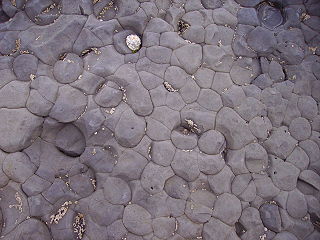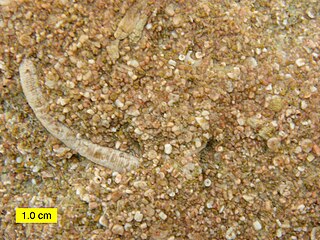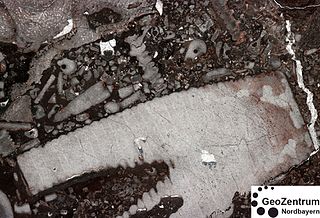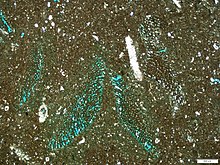
Limestone is a type of carbonate sedimentary rock which is the main source of the material lime. It is composed mostly of the minerals calcite and aragonite, which are different crystal forms of CaCO3. Limestone forms when these minerals precipitate out of water containing dissolved calcium. This can take place through both biological and nonbiological processes, though biological processes, such as the accumulation of corals and shells in the sea, have likely been more important for the last 540 million years. Limestone often contains fossils which provide scientists with information on ancient environments and on the evolution of life.

Sandstone is a clastic sedimentary rock composed mainly of sand-sized silicate grains. Sandstones comprise about 20–25% of all sedimentary rocks.

Sedimentary rocks are types of rock that are formed by the accumulation or deposition of mineral or organic particles at Earth's surface, followed by cementation. Sedimentation is the collective name for processes that cause these particles to settle in place. The particles that form a sedimentary rock are called sediment, and may be composed of geological detritus (minerals) or biological detritus. The geological detritus originated from weathering and erosion of existing rocks, or from the solidification of molten lava blobs erupted by volcanoes. The geological detritus is transported to the place of deposition by water, wind, ice or mass movement, which are called agents of denudation. Biological detritus was formed by bodies and parts of dead aquatic organisms, as well as their fecal mass, suspended in water and slowly piling up on the floor of water bodies. Sedimentation may also occur as dissolved minerals precipitate from water solution.
Sedimentology encompasses the study of modern sediments such as sand, silt, and clay, and the processes that result in their formation, transport, deposition and diagenesis. Sedimentologists apply their understanding of modern processes to interpret geologic history through observations of sedimentary rocks and sedimentary structures.

The lithology of a rock unit is a description of its physical characteristics visible at outcrop, in hand or core samples, or with low magnification microscopy. Physical characteristics include colour, texture, grain size, and composition. Lithology may refer to either a detailed description of these characteristics, or a summary of the gross physical character of a rock. Examples of lithologies in the second sense include sandstone, slate, basalt, or limestone.

Conglomerate is a clastic sedimentary rock that is composed of a substantial fraction of rounded to subangular gravel-size clasts. A conglomerate typically contains a matrix of finer-grained sediments, such as sand, silt, or clay, which fills the interstices between the clasts. The clasts and matrix are typically cemented by calcium carbonate, iron oxide, silica, or hardened clay.

Mudstone, a type of mudrock, is a fine-grained sedimentary rock whose original constituents were clays or muds. Mudstone is distinguished from shale by its lack of fissility.

Mudrocks are a class of fine-grained siliciclastic sedimentary rocks. The varying types of mudrocks include siltstone, claystone, mudstone, slate, and shale. Most of the particles of which the stone is composed are less than 1⁄16 mm and are too small to study readily in the field. At first sight, the rock types appear quite similar; however, there are important differences in composition and nomenclature.
The Folk classification, in geology, is a technical descriptive classification of sedimentary rocks devised by Robert L. Folk, an influential sedimentary petrologist and Professor Emeritus at the University of Texas.

Clastic rocks are composed of fragments, or clasts, of pre-existing minerals and rock. A clast is a fragment of geological detritus, chunks, and smaller grains of rock broken off other rocks by physical weathering. Geologists use the term clastic to refer to sedimentary rocks and particles in sediment transport, whether in suspension or as bed load, and in sediment deposits.

Under the Dunham classification system of limestones, a wackestone is defined as a mud-supported carbonate rock that contains greater than 10% grains. Most recently, this definition has been clarified as a carbonate-dominated rock in which the carbonate mud component supports a fabric comprising 10% or more very fine-sand grade or larger grains but where less than 10% of the rock is formed of grains larger than sand grade .

Under the Dunham classification system of limestones, a grainstone is defined as a grain-supported carbonate rock that contains less than 1% mud-grade material. This definition has recently been clarified as a carbonate-dominated rock that does not contain any carbonate mud and where less than 10% of the components are larger than 2 mm. The spaces between grains may be empty (pores) or filled by cement.

Under the Dunham classification system of limestones, a packstone is defined as a grain-supported carbonate rock that contains 1% or more mud-grade fraction. This definition has been clarified by Lokier and Al Junaibi (2016) as a carbonate-dominated lithology containing carbonate mud in a fabric supported by a sand grade grain-size fraction and where less than 10% of the volume consists of grains >2 mm.

Floatstone is a type of carbonate rock.

Rudstone is a type of carbonate rock.

Bafflestone is a type of carbonate rock.
A boundstone is a special type of carbonate rock in the Dunham classification
Bindstone is a special type of carbonate rock in the Dunham classification. The term did not appear in the original Dunham classification from 1962 and was introduced by Embry and Klovan 1971 in the modified Dunham classification.
A framestone is a special type of carbonate rock in the Dunham classification.





















